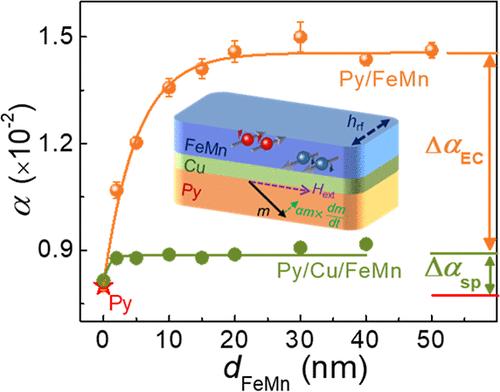交换耦合诱导的Py/FeMn界面自旋动态阻尼调制
IF 8.2
2区 材料科学
Q1 MATERIALS SCIENCE, MULTIDISCIPLINARY
引用次数: 0
摘要
自旋动态阻尼对于磁存储、传感器和逻辑系统的应用至关重要。本文以界面反铁磁交换耦合为重点,系统地研究了Ni80Fe20(Py)/Fe50Mn50(FeMn)双分子层的磁动力学。当FeMn厚度超过5 nm时,界面交换偏置场出现,Py/FeMn双分子层的自旋动态阻尼显著增加至0.015左右。在Py和FeMn层之间引入Cu间隔层,自旋动态阻尼显著降低,消除了界面交换偏置效应。然而,在Py/Cu/FeMn三层中观察到轻微的阻尼增加,这归因于自旋泵送机制。根据自旋抽运理论,估算出Py/Cu/FeMn中界面自旋混合电导为3.44 nm-2,这是由于FeMn层的自旋-轨道耦合较弱所致。这些发现表明,Py/FeMn双层膜的动态阻尼主要是由界面交换耦合驱动的,而不是自旋泵浦效应。此外,通过在Py/Pt和Py/Cu界面上使用FeMn作为插入物,我们证明了FeMn层的自旋扩散长度较短,并且我们证实了界面交换耦合在增强自旋动态阻尼方面的关键作用。Py/FeMn界面处的交换耦合促进了自旋弛豫,导致阻尼增强,阻止了自旋从Py到Pt (Cu)层的传输。这些发现表明,将反铁磁材料与交换耦合界面集成可以显著促进高频自旋电子的应用。本文章由计算机程序翻译,如有差异,请以英文原文为准。

Exchange Coupling-Induced Spin Dynamic Damping Modulation at the Py/FeMn Interface
The spin dynamic damping is crucial for applications in magnetic memory, sensors, and logical systems. Here, focusing on interfacial antiferromagnetic exchange coupling, the magneto-dynamics of Ni80Fe20(Py)/Fe50Mn50(FeMn) bilayers is systematically investigated. When the FeMn thickness exceeds 5 nm, an interfacial exchange bias field appears, significantly increasing the spin dynamic damping of the Py/FeMn bilayer to around 0.015. A Cu spacer is introduced between the Py and FeMn layers, and the interfacial exchange bias effect is eliminated following a dramatic decrease in the spin dynamic damping. However, a slight damping increment is observed in Py/Cu/FeMn trilayers, which is attributed to the spin pumping mechanism. Based on spin pumping theory, the estimated interfacial spin mixing conductance is 3.44 nm–2 in Py/Cu/FeMn, which is attributed to the weak spin–orbit coupling of the FeMn layer. These findings indicate that the dynamic damping of Py/FeMn bilayers is primarily driven by interfacial exchange coupling rather than the spin pumping effect. Furthermore, by employing FeMn as an insertion at Py/Pt and Py/Cu interfaces, we demonstrate the short spin diffusion length for the FeMn layer, and we confirm the critical role of interfacial exchange coupling in enhancing spin dynamic damping. The exchange coupling at the Py/FeMn interface facilitates spin relaxation, resulting in the damping enhancement and blocking spin transmission from the Py to Pt (Cu) layer. These findings suggest that integrating antiferromagnetic materials with exchange coupling interfaces could significantly boost high-frequency spintronic applications.
求助全文
通过发布文献求助,成功后即可免费获取论文全文。
去求助
来源期刊

ACS Applied Materials & Interfaces
工程技术-材料科学:综合
CiteScore
16.00
自引率
6.30%
发文量
4978
审稿时长
1.8 months
期刊介绍:
ACS Applied Materials & Interfaces is a leading interdisciplinary journal that brings together chemists, engineers, physicists, and biologists to explore the development and utilization of newly-discovered materials and interfacial processes for specific applications. Our journal has experienced remarkable growth since its establishment in 2009, both in terms of the number of articles published and the impact of the research showcased. We are proud to foster a truly global community, with the majority of published articles originating from outside the United States, reflecting the rapid growth of applied research worldwide.
 求助内容:
求助内容: 应助结果提醒方式:
应助结果提醒方式:


